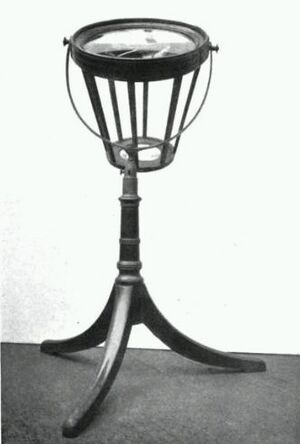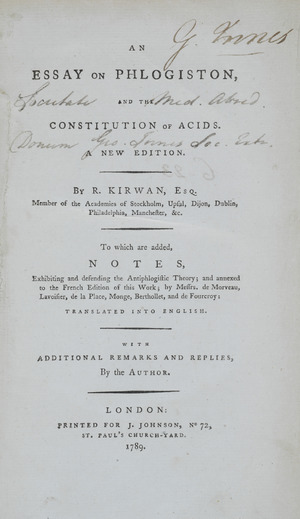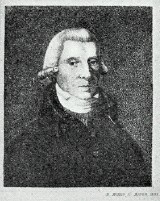Richard Kirwan facts for kids
Quick facts for kids
Richard Kirwan
|
|
|---|---|
 |
|
| Born | 1 August 1733 Cloughballymore, County Galway, Ireland
|
| Died | June 22, 1812 (aged 78) |
| Known for | Phlogiston |
| Scientific career | |
| Fields | Chemistry |
Richard Kirwan (born August 1, 1733 – died June 22, 1812) was an important Irish scientist. He was a geologist and a chemist. He was one of the last scientists to believe in an old idea called the phlogiston theory.
Kirwan worked in many science areas, like chemistry, meteorology (the study of weather), and geology (the study of Earth). He was very famous in his time. He wrote letters to and met with other well-known scientists such as Lavoisier, Black, Priestley, and Cavendish.
Contents
A Scientist's Journey
Richard Kirwan was born in Cloughballymore, County Galway, Ireland. He was the second son in his family. When he was young, he spent some time living abroad. In 1754, he joined a religious group called the Jesuits. However, he returned to Ireland the next year. This was because his brother died, and Richard inherited the family's land.
In 1757, Kirwan got married, but his wife passed away eight years later. They had two daughters named Maria Theresa and Eliza.
In 1766, Kirwan became a lawyer in Ireland. But just two years later, in 1768, he decided to stop being a lawyer. He wanted to focus all his time on science instead.
Life in London
For the next 19 years, Richard Kirwan lived mostly in London, England. He enjoyed spending time with other scientists there. He also wrote many letters to scientists in other countries. He could do this easily because he knew many different languages.
Kirwan did experiments on how heavy different salty substances were. He also studied how they attracted each other. This work helped improve the ways scientists analyzed chemicals. In 1782, he won a special award called the Copley medal for his work. He had become a member of the Royal Society in 1780, which is a very old and respected science group.
In 1784, he had a friendly debate with Henry Cavendish about experiments on air. Kirwan was also chosen as a member of important science groups in Sweden and America.
Moving to Dublin
In 1787, Kirwan moved back to Dublin, Ireland. In 1799, he became the president of the Royal Irish Academy. This was another important science group. He stayed president until he died.
He wrote about 38 papers for the Academy. These papers covered many topics like weather, chemistry, geology, magnetism, and the study of languages. One of his papers was about the early Earth and a big event that changed it. This led to a lively discussion with scientists who believed in the Huttonian theory of Earth's formation.
Kirwan believed in the idea of a great flood that covered the whole Earth. He found fossils near Portrush and thought they proved that a type of rock called basalt formed in water.
The Phlogiston Theory
Richard Kirwan was one of the last scientists in Britain and Ireland to support the phlogiston theory. This old theory tried to explain why things burn. Kirwan wrote a book about it in 1787 called Essay on Phlogiston and the Constitution of Acids. In this book, he said that phlogiston was actually hydrogen.
His book was translated into French by Marie-Anne Pierette Paulze. Other famous scientists, like Lavoisier, added their own notes to the French version. These notes disagreed with Kirwan's ideas. Kirwan tried to prove them wrong, but their arguments were very strong. In 1791, he finally agreed that the phlogiston theory was incorrect.
Political Involvement
There is some information that suggests Kirwan might have been part of a group called the Society of the United Irishmen. This group was formed in 1791 by Irish Protestants who wanted to make changes in Ireland. They were inspired by the American and French revolutions.
The United Irishmen wanted all people in Ireland to have equal rights, including Catholics. They also wanted to change how Ireland was ruled by Britain. This movement led to a big rebellion in 1798. The rebellion was defeated, and then the Act of Union joined Ireland and Great Britain.
When the Act of Union happened, Kirwan was offered a special title, but he said no. He died in Dublin in June 1812 and was buried there.
Interesting Habits
People told many stories about Richard Kirwan's unique habits and how good he was at talking.
- He really disliked flies. He even paid his servants money for every fly they killed!
- He had a pet eagle and six large dogs that stayed with him.
- He didn't like visitors who came late. So, he would have the door-knocker removed every evening at seven o'clock.
- Kirwan had trouble swallowing food, so he always ate alone.
- He had a very specific diet: only ham and milk. The ham was cooked on Sunday and then reheated for the rest of the week.
- He was very worried about catching a cold. Because of this, he kept his living room heated with a fire all year round. He also always wore an overcoat, even when he was inside his house.
Awards and Memberships
Richard Kirwan received many honors and was a member of important scientific groups:
- Fellow of the Royal Society (1780)
- Copley Medal (1782)
- Foreign Honorary Member of the American Academy of Arts and Sciences (1789)
- President of the Royal Irish Academy (1799–1812)
- Honorary founding member of the Wernerian Natural History Society of Edinburgh (1808)
Books by Richard Kirwan
Richard Kirwan wrote several important books during his life:
- Elements of Mineralogy (1784)
- Essay on Phlogiston and the Constitution of Acids (1787)
- An Estimate of the Temperature of Different Latitudes (1787)
- Essay of the Analysis of Mineral Waters (1799)
- Geological Essays (1799)
- The Manures Most Advantageously Applicable to the Various Sorts of Soils (1796; sixth edition in 1806)
- Logick (1807)
- Metaphysical Essays (1809)
- An Essay on Human Happiness (1810)




